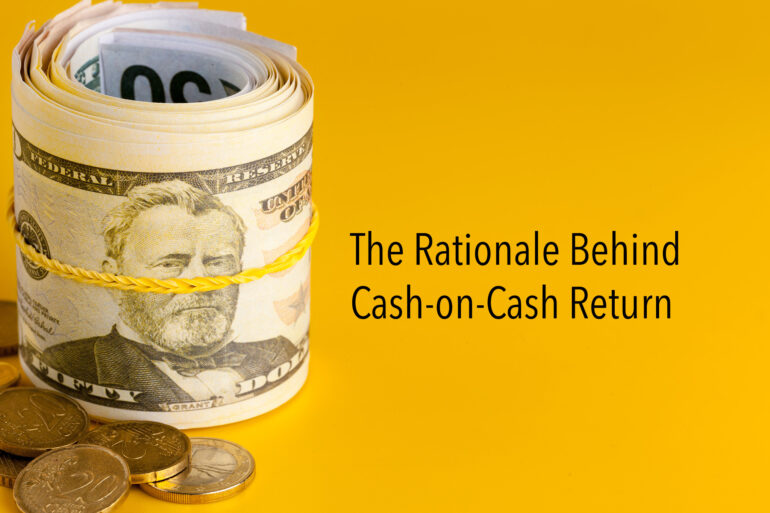The Rationale Behind Cash-on-Cash Return In Real Estate
Real estate investing is a huge undertaking that requires significant time and money. As a real estate investor, you want to know that you’re doing everything to ensure your investment is safe and secure.
The cash-on-cash return is a measure that investors use to evaluate the investment potential of a real estate property.
You want your investments to be profitable, and not just in the short term. You also want to know that your investments are working for you over time. Therefore, you can reap the benefits of compound interest as well as leverage the power of tax deductions.
When determining how much you can afford to invest in real estate, one of the most important metrics to consider is the cash-on-cash return.
The term is widely used among investors and developers, but it’s not always easy to understand what the metric means or how it can be applied. In this article, we’ll go over what exactly cash on cash return is, and how you can use it to make better decisions about your real estate investments.
What is Cash-on-Cash Return in Real Estate for Investors
The cash-on-cash return is a measure that investors use to evaluate the investment potential of a real estate property. The measure takes into account both the principal invested and the amount of cash flow generated by the investment, according to Investopedia. It is calculated by dividing the annual cash flow by the amount of money put into the deal (or equity). The resulting number indicates how much money an investor can expect to receive on an annual basis if the property continues to perform as it has in the past.
So, while it may be true that only one type of income can be considered “cash,” this measure is still useful when evaluating investments because it focuses on some fairly essential factors. First and foremost, it considers present value, which is important because investors are interested in what they will receive if they invest today, as opposed to waiting for payment over a long period.
Additionally, it accounts for expenses, like principal and interest payments, that must be made on any loan taken out for the acquisition or improvement of real estate; these costs are not “cash” but are still necessary for your investment to pay off.
The most common way to determine cash-on-cash return is to use an amortization schedule. In an amortization schedule, each year’s expenses and income are spread over the loan term. This helps to bridge the gap between monthly payments and yearly expenses and income. Once you have determined your total income and expenses for each year, you can subtract your expenses from your income to get your cash flow. Then, divide your total capital invested by your cash flow and multiply the result by 100 to get a percentage that reveals your cash-on-cash return.
While an investor might be lucky enough to find a property with a 20% cash-on-cash return, this is not typical.
How to Calculate Cash-on-Cash Return
Cash-on-cash return (COCR) is a metric that investors use to assess the performance of their real estate investments. It’s calculated by dividing the cash flow of a property by the amount of cash invested in it.
To calculate your cash-on-cash return, you’ll need to know:
- The current value of your property. What you paid for it, less any expenses incurred during renovations.
- The current rent you’re getting from tenants living in your property.
- The total amount of money that you’ve put into the property. This includes any costs associated with buying and selling it.
To calculate COCR, you’ll need to know how much money your property was worth when you bought it, and how much money you spent to buy it. Then, subtract those costs from the total rent your property generates in a year.
If you have any debt on the property, include interest payments on those debts as well. Next, add in any other expenses related to maintaining the property and keeping it running smoothly. These might include recurring expenses like:
- Property taxes and insurance
- Utilities
- Vacancy rate
- Maintenance costs
- Property management fees
- HOA fees (if applicable)
- Vacancy rate
Then, subtract them from what you’ve earned from renting out your property during that period as well.
Finally, divide what’s left over by what you paid for everything combined. The resulting number will be your COCR expressed as a percentage.
The formula for calculating cash-on-cash return is:
Cash-on-Cash Return = (Annual Cash Flow / Initial Cash Outlay ) x 100%
For example, let’s say you bought a duplex for $100,000 and put another $20,000 into renovations. You, then, rent out both units for $800/month each. After 12 months of renting, you’ve collected $9,600 ($800 x 12 months). This means that your total return is:
Cash-on-cash Return = ($9,600 / $80,000) × 100 = 11%
You can use our online calculator available for premium members who also enjoy an array of perks. This calculator automatically calculates your cash-on-cash return based on your inputs.
Cash-on-cash return measures the actual return on your investment, rather than the potential return on your investment.
What is a Good Cash-on-Cash Return for Real Estate?
While an investor might be lucky enough to find a property with a 20% cash-on-cash return, this is not typical. In general, most investors will look for a property with a 10-12% cash-on-cash return. While this might not sound like much, it is crucial to remember that real estate investments are about long-term value.
Therefore, 10-12% is good and can be very profitable over time.
A good cash-on-cash return can vary widely depending on your situation. It depends on how much money you put down, what kind of loan terms you can negotiate with a bank or private lenders, and whether or not you need to make improvements before you can start renting the property. The best way to determine how much cash you should put down when purchasing real estate is by calculating your personal finance goals and deciding how much risk you are willing to take.
Why Does Cash-on-Cash Return Matter?
Cash-on-cash return is an important measure of the financial health of a real estate investment. Investors commonly use this metric to evaluate the performance of their properties.
But why does it matter? Here are five reasons:
- It’s simple to calculate. Many real estate metrics require a lot of complicated math, but cash-on-cash return is straightforward.
- It lets you compare apples to apples when evaluating different types of investments to see which will perform best for your needs (e.g., residential vs commercial).
- Cash-on-cash return measures the actual return on your investment, rather than the potential return on your investment. It is a more accurate indicator of how much profit you can expect to earn over time.
- Cash-on-cash return is useful for evaluating a real estate investment property because it compares the actual amount of money returned (in this case, your monthly rental payments) to the amount of money invested in that property (the down payment and closing costs). This lets you know how quickly your investment will pay off and whether it’s worth it.
- Cash-on-cash return is also helpful when deciding to refinance your mortgage. This decision should be based on whether refinancing makes financial sense for you at this point, not just because it saves you money today!
Cash-on-cash return is an important metric that can help you make better decisions about your real estate investments.
What Can You Do to Improve Your Cash-on-Cash Return?
If you’re looking to improve your cash-on-cash return, there are a few things you can do. Here are some of the most effective ways to increase your returns:
- Increase your total return on investment by reinvesting any of the funds that were not used for the initial purchase of the property into other properties with similar risk profiles and growth potential.
- If you have enough equity in your current property, consider borrowing against it to fund some, or all, of the purchase price of another property. This will allow you to increase both your equity and return on investment.
- Reduce the amount of interest you pay over time by refinancing your loan with a lower interest rate or shorter term when possible.
- Increase the value of your property by increasing rents, increasing occupancy rates for each unit, or improving their condition. They will garner a higher price point when it’s time to sell them off as part of your portfolio strategy.
- Increase your down payment. A down payment is the amount of money you pay toward the purchase price before you get any financing. If you make a larger down payment, there will be less money left over to finance, which means you will have less interest to pay back over time. This will increase your cash-on-cash return.
- Buy in an up-and-coming area. The prices will likely go up quickly over time due to increased demand for real estate in the area. As prices go up, so do your equity and overall return on investment (ROI). This increases your cash-on-cash return as well as gives you more potential for capital gains tax savings (if applicable).
Unlock Massive Cash Flow by Investing Wisely!
Cash-on-cash return is an important metric that can help you make better decisions about your real estate investments. It’s also a great way to measure the effectiveness of your investment strategy, and it gives you a way to compare your performance against other investors in the same market.
If you’re looking for ways to improve your cash-on-cash return in real estate, you can do several things to increase your ROI. The most important one is investing wisely: finding properties that will appreciate over time and holding them for as long as possible. Other strategies include buying undervalued properties, renting out properties with low vacancy rates, and avoiding expensive repairs or renovations.
No matter what strategy you use, though, it’s essential to keep track of all these factors so you can make informed decisions about your investments and use them as benchmarks for future performance. Find more real estate investing tips by visiting our hand-curated educational section.
If you are interested in investing in real estate but don’t know where to start, don’t worry! We have all the information you need right here. We hope this article helped you understand more about cash-on-cash return and its importance when evaluating your investments!








